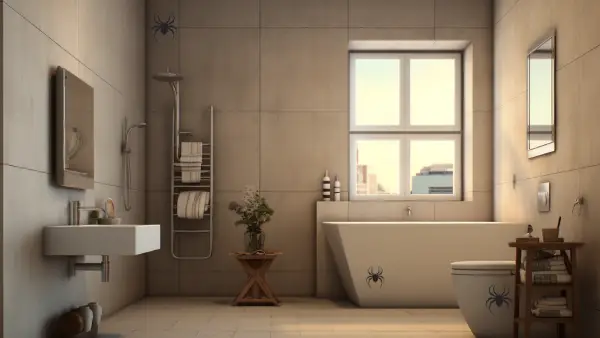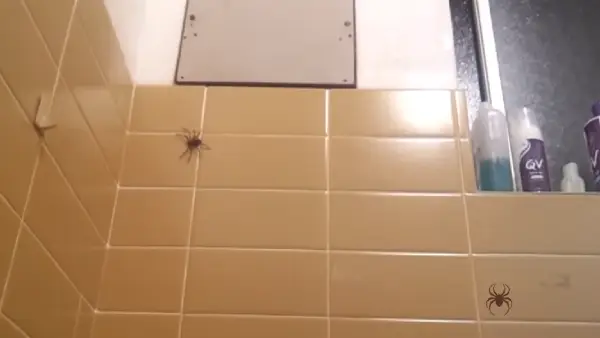Last Updated on November 14, 2023
Tiny black spiders in your bathroom is a common and unsettling experience. Because of moisture, prey potential, and hidden corners in bathrooms, these small arachnids belong to the Theridiidae family, commonly known as cobweb spiders.
To get rid of tiny black spiders in your bathroom, identify the spider species, so you can tailor your approach accordingly. Declutter your bathroom and thoroughly clean it to disrupt its hiding spots. Seal any entry points, such as cracks and gaps, to prevent their entry.
Here, we’ll discuss the reasons behind their existence and provide you with practical solutions to bid them farewell. So grab your spider-slaying gear and get ready to reclaim your bathroom from these unwelcome guests.
How Do You Get Rid of Tiny Black Spiders in Your Bathroom?

When you’re dealing with tiny black spiders in your bathroom, there are several steps you can take to eliminate them.
- Step 01: Identify the spider species
- Step 02: Remove clutter and clean thoroughly
- Step 03: Seal entry points
- Step 04: Apply natural repellents
- Step 05: Use spider traps
Let’s take a closer look at each step to see what we can do about the tiny black spiders in your bathroom.
Step 01: Identify the Spider Species
To accurately identify the species of the tiny black spiders in your bathroom, consult a professional pest control expert. Identifying spider species can be challenging for you due to their similarities in appearance.
You can take picture samples of the spiders and seek help from a professional who can accurately identify the species you’re dealing with. Also, you should identify the species because different spiders may require different removal methods.
But most tiny black spiders can be removed with the same techniques.
Step 02: Remove Clutter and Clean Thoroughly
Take action by decluttering your bathroom and removing items from shelves, cabinets, and corners where spiders might hide. Then, thoroughly clean these areas to disrupt their hiding places.
Spiders are attracted to cluttered areas because they provide ample hiding spots and prey. By eliminating unnecessary items, you create a less appealing environment for them.
Take advantage of the vacuum cleaner’s extension hose to get spiderwebs and eggs from walls, ceilings, corners, and other difficult places. Keep an eye out for dark spaces such as behind toilets or under sinks.
Step 03: Seal Entry Points
Check your bathroom thoroughly to identify any cracks, gaps, or openings that spiders, ants or bed bugs could use to enter. Spiders are small creatures like termites that can squeeze through the tiniest of spaces. They often seek shelter in bathrooms due to the moisture and abundance of insects for food.
Also, inspect areas around pipes, wires, and baseboards, as these are common entry points for spiders. Use a flashlight to get a closer look at potential hiding spots. Apply caulk or sealant generously to close off any gaps you find. Make sure the sealant is appropriate for the material you are sealing.
Step 04: Apply Natural Repellents
Use a spray bottle to apply the natural repellents, like white vinegar or citrus oils mixed with water, around your bathroom. These substances have properties that spiders find repulsive, keeping these tiny black insects away.
When using white vinegar as a repellent, dilute it with water to avoid surface damage. Citrus oils, such as lemon or orange, contain compounds that spiders dislike and can be mixed in spray bottles with water for easy application. Also, peppermint oil has been found to deter spiders due to its strong scent.
Step 05: Use Spider Traps
Now, you can place spider traps or sticky traps in areas with high spider activity to capture spiders as they move around. Spider traps are an effective method for controlling tiny black spiders in your bathroom. By attracting and immobilizing spiders, these traps prevent them from moving around your space.
Why Do Tiny Black Spiders Exist in Bathrooms?
There are several key reasons why tiny black spiders exist in bathrooms.
No 01. Moisture
Bathrooms provide a perfect breeding ground for these creatures due to the high humidity levels resulting from showering and bathing. Moisture is crucial in attracting spiders, as it creates an environment where they can thrive.
This excess moisture can grow mold when left unchecked, further attracting spiders. The conditions are also ideal for mushroom growth.
Your bathroom’s ventilation reduces humidity levels by circulating fresh air and removing moisture. Ensure your bathroom has proper exhaust fans or windows that can be opened for effective ventilation.
No 02. Prey Availability
Spiders are attracted to bathrooms because they provide a steady supply of small insects like ants, flies, and gnats. These insects are drawn to the water sources, toiletries, and organic matter commonly found in bathrooms.
By sealing food containers tightly and promptly disposing of trash, you can limit these small insects’ access to potential food sources. This will decrease the attractiveness of your bathroom for spiders looking for prey.
No 03. Dark and Hidden Spaces
Dark, undisturbed corners and crevices provide a haven for spiders to nest and build their webs. Bathrooms, with their often neglected nooks and crannies, offer the perfect environment for these tiny arachnids to thrive.
In these hidden spaces, spiders can find protection from potential predators, such as humans or other larger insects that may try to disturb them. The dark nature of these areas also provides the ideal conditions for spider nesting, as they prefer dimly lit environments.
No 04. Easy Access
It’s easy for these creatures to enter your bathroom through small openings around doors, windows, plumbing fixtures, and vents. Spiders are adept at finding their way into enclosed spaces, and your bathroom provides just the right environment.
No 05. Suitable Surfaces
Smooth and vertical surfaces in your bathroom make it easier for spiders to attach their webs and catch prey. Bathroom tiles, walls, and ceilings provide ideal platforms for these tiny black spiders.
The smoothness of these surfaces allows the spiders to anchor their silk threads securely, ensuring stability for their intricate web structures.
No 06. Overwintering
Bathrooms tend to be slightly warmer than outdoors, providing a more stable temperature for survival. Also, bathrooms often have higher humidity levels due to regular water use, creating an ideal habitat for spiders that require moisture.
What kind of spiders live in the bathroom?

Some common spiders that live in bathrooms include house spiders, daddy long legs, hobo spiders, jumping spiders, cellar spiders, and occasionally wolf spiders.
These arachnids are often attracted to the bathroom environment due to the abundance of moisture and potential prey.
Keep Your Bathroom Spider-Free
You’ve successfully figured out how to eradicate those pesky, tiny black spiders that invade your bathroom. By implementing the techniques discussed in this article, you can ensure a spider-free zone and restore peace and tranquility to your daily bathing routine.
In fact, these eight-legged intruders are simply seeking shelter and moisture. But with your newfound knowledge, you can reclaim your bathroom as a sanctuary of cleanliness.
So, the next time you see a small black spider lurking in your bathroom corner, don’t be alarmed. Instead, take action and follow these steps to eliminate them for good.

